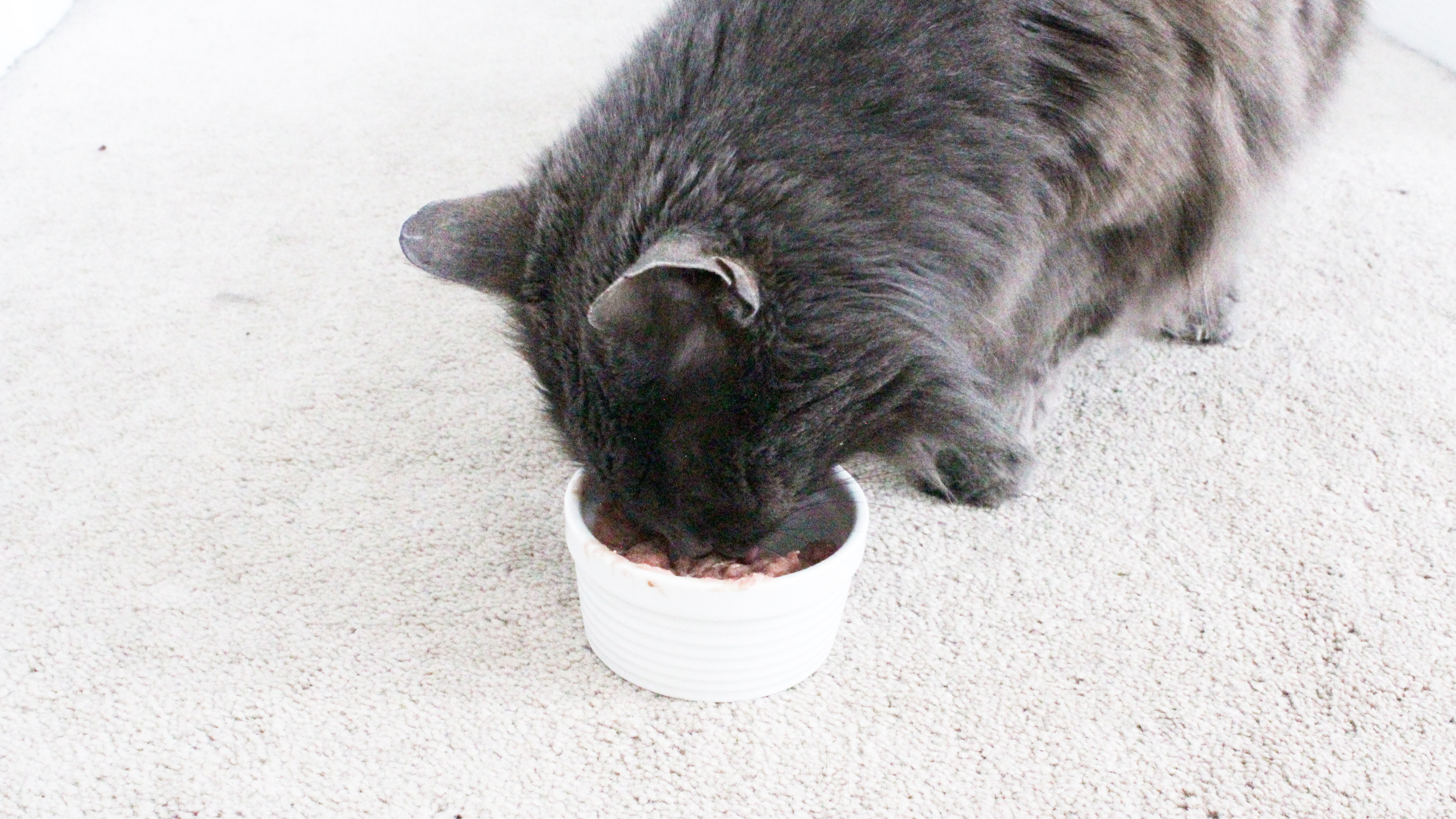
Pet owners have been duped by the billion-dollar pet food, well-intentioned veterinarians, and advertising disguised as educational content.
There is nothing commercial pet food provides that you can’t make in your own kitchen other than a high price markup, depressingly inferior ingredients, disease-causing fillers, and a fancy label.
Here’s an easy, cheap way to get cats the nutrients they need. Like so much in human nutrition, feeding cats is actually very simple once you take out the dogma. See the 2 rules for feeding cats below, and when you follow those rules, you’re on your way to good pet health at a fraction of the price.

Do you see it? Annie the mighty hunter has a mouse and isn’t happy with me coming near it.
Take a look at the bigger picture (how cats eat in the wild) and stop trying to apply human nutrition myths to our pets, your pet will get the food it needs to live a long healthy life.
Raw rules food for Cats
There are two main rules for feeding cats. When you follow these, you’re working with the cat’s natural nutritional patterns.
- Feed your cat nose-to-tail animals that are smaller than they are (what they could realistically catch in the wild). This includes bones, muscles, and organs – especially the heart.
- If your food is not fresh and raw, supplement with the essential (for cats) amino acid taurine. (source)

This recipe may sound exotic and difficult, but in reality it’s no harder than making a smoothie and costs less than 5 cans of commercial Kidney Care cat food.
Raw Food for Kidney Disease
Cats that have been raised on commercial food with its dead, dry, nutritionally inferior ingredients are susceptible to kidney disease. Once kidney disease has started, it is a progressive disease and the #1 reason for housecat mortality other than trauma. (source)
To help cats that have already started this process have the highest quality of life they can, and slow the progression as much as possible, a raw food diet that is loaded with nutrients but low in phosphorus is key. (source)
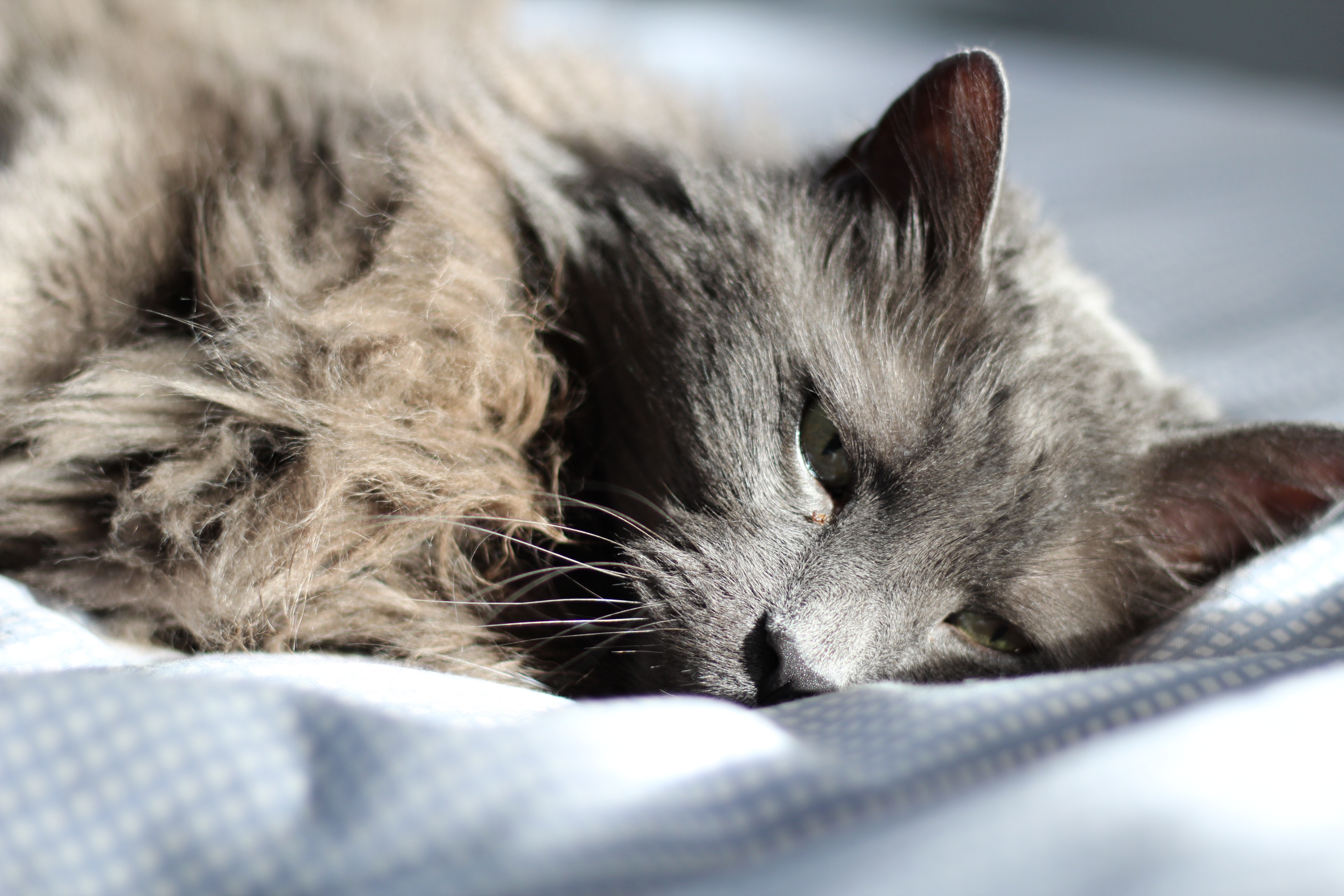
My Experience Feeding Raw Food to Pets
Bob the cat came into my life a year ago as a 14-year-old Maine Coon. He had some health issues the year before, prompting an overnight vet stay, myriad of tests, and no answers. Bob’s health had mostly recovered, to the point that his owner and vet weren’t overly concerned. But still, he wasn’t thriving.
Last spring he started having health issues again, with frequent indoor accidents, ‘drunk’ behavior, weight loss, lethargy, and excessive thirst. This time he was diagnosed with hyperthyroid and early-stage kidney disease. He was sent home with medication to tone down his thyroid dysfunction and special ‘kidney care’ cat food.

Trying raw cat food for kidney disease
Bob got better on the special food and thyroid medication, but still wasn’t great. And the cost was ridiculous, costing over $100/month to feed and medicate this 15-pound cat.
I had success a decade earlier feeding my dog raw food, with his weird skin condition clearing up, as well as his digestive upset. Still, I knew feeding cats was different than feeding dogs so I wanted to make sure I didn’t mess up the cat.
The internet provides dozens of different options for cat food, with some containing ingredients I know the cat doesn’t eat (psyllium husk or brown rice? No thank you! The cat is a carnivore, thankyouverymuch) to commercially available raw food at a hefty price to cooked recipes using vegetables.
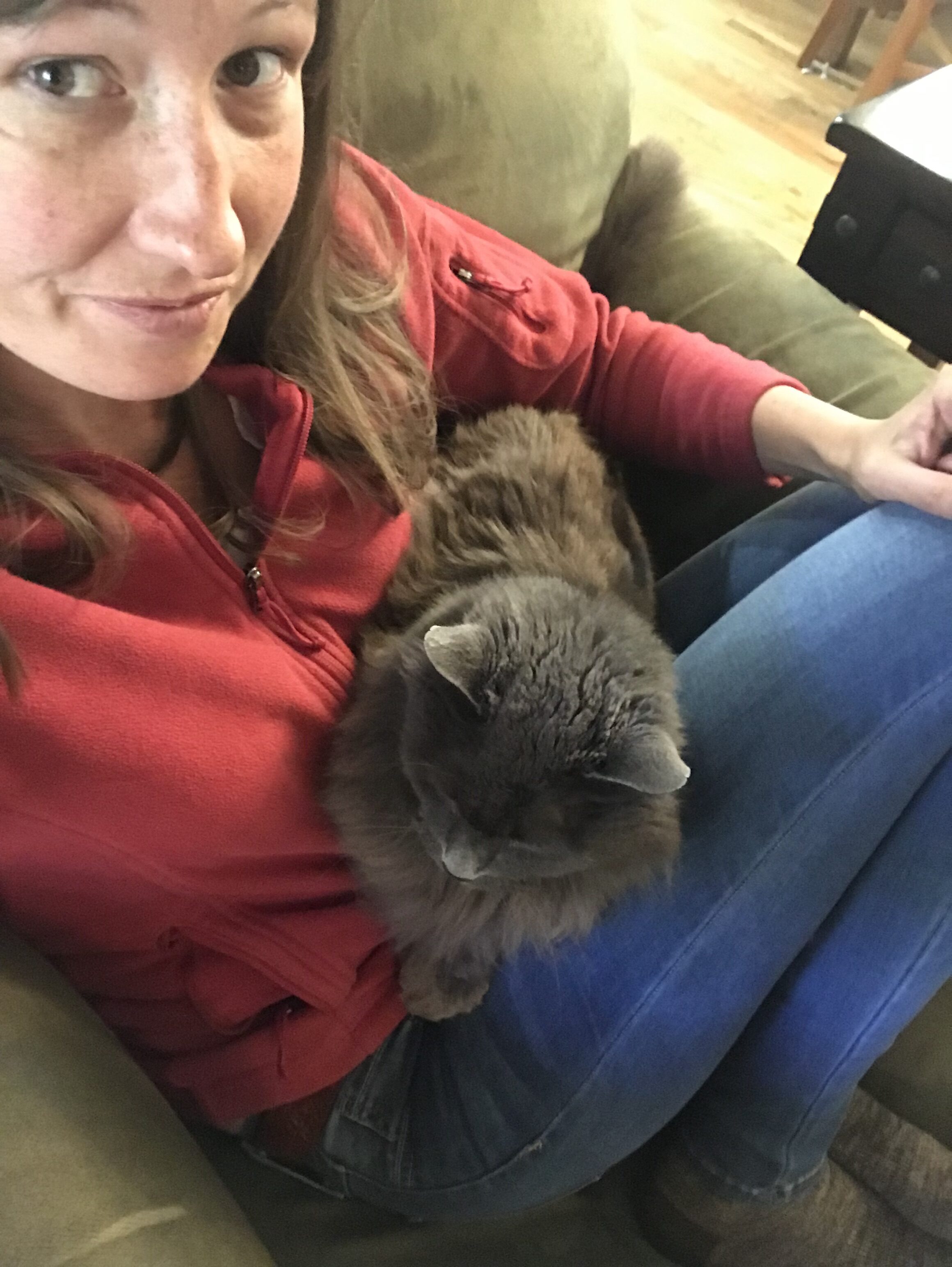
Finally, I found a facebook group that seemed to know what they were talking about and had a recipe that included ingredients that made sense to me for the cat.
This recipe, combined with Bob’s love for salmon, and the phosphate limit that the vet recommended, has been the winning ticket for returning Bob to good health with a food that is easy on the budget (about $10 per month!).
And becoming his personal chef totally won over the cat, who was rumored to ‘hate everyone’ other than his owner before I came along. I’m still not really a cat person, but I like this one ❤️
Raw Food Recipe for Cats with Kidney Disease
Ingredients notes: You can find the organ meats at US Wellness Meats (here). It looks expensive at first, but 100 g of liver, kidney, etc is a super small amount so one purchase from US Wellness will probably last you for an entire year! Just add in easy-to-find ground beef and you’re good to go!
Put the unused portion of the organ meats back in the freezer for later. I don’t completely thaw them, I just thaw the organ meats enough that I can cut a chunk off.
The heart has to be chicken (or other small animal) heart or you must supplement with taurine. The kidney can be any kind of kidney. Don’t add more liver than recommended, due to vitamin A toxicity potential on a diet higher in liver. Remember, we’re trying to replicate what the cat would eat in the wild from their catches- a combination of majority muscle meat with a little organ meat as well.
Directions notes: Watch the first video to see how easy this cat food is to make!
Supplement notes: Fulvic and Humic is shown to have benefit when it comes to kidney repair in rats. For cats, a recommendation of 1/4 teaspoon per 20 pounds of weight can be used daily mixed into wet food or water.
Study: https://pubmed.ncbi.nlm.nih.gov/2953069/
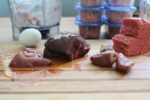
Beef and Salmon-Based Raw Kidney Care Cat Food Recipe
This is Bob's favorite cat food, which we're using for kidney care. If your cat is not diagnosed with kidney disease, it is encouraged to use bones in place of the egg shell.
Ingredients
- 50 grams chicken liver
- 50 grams beef kidney
- 2 cups water more as needed to puree
- 6 grams ground egg shell save your egg shells, bake at 350* for 15 minutes, and then crush with a mortar and pestle.
- 1 whole raw egg
- 100 grams chicken heart
- 700 grams ground beef 70/30
- 100 grams raw salmon bones removed
- 14 g sardine or salmon oil
Recipe Notes
This works best to puree all the organ meats (heart, kidney, etc) into the water, and then pulse this mixture into the ground beef. If you have a Vitamix this should work just fine (just pulse and allow to rest if it sounds like it's over working). If you have a regular blender, I would mix the water/organ mixture and the ground beef by hand or with a stand mixer instead.
Divide out into containers and thaw 2-3 days' worth at a time.
Phosphorus calculations, aiming for less than 100 mg phosphorus per 100 calories:
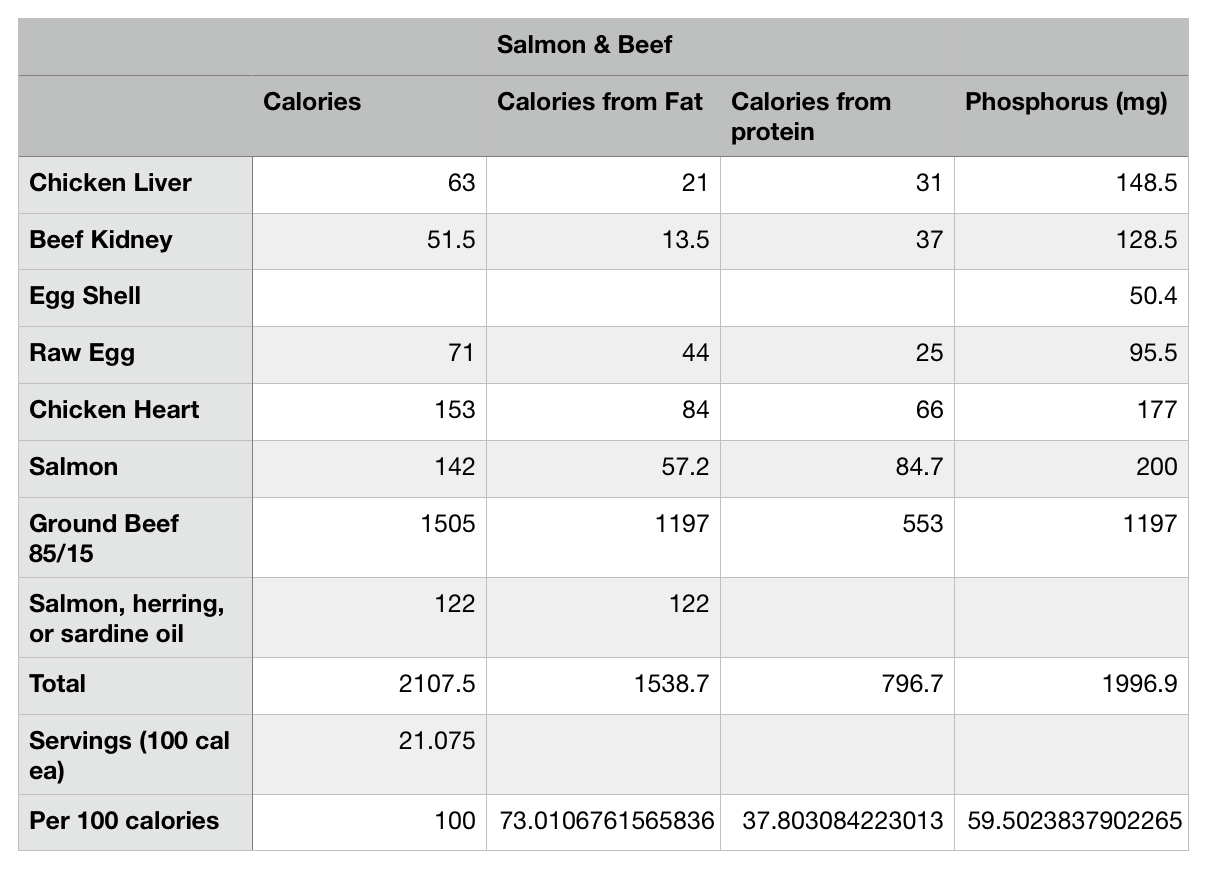

Is this recipe enough taurine? I wasn’t sure, since taurine in the chicken heart may degrade when it’s frozen, and my chicken hearts come frozen. Since taurine is so essential to cats, I sprinkle powdered taurine, 1 pinch, on each container of his food (2 days’ worth).
Ingredient Nutrition notes:
50 grams chicken liver Per 50 g: 63 calories, 21 calories from fat, 31 calories from protein, 294 mcg folate, .9 mg riboflavin, 0.85 mg niacin, 8.3 mcg B12, 84 mg choline, 148.5 mg phosphorus
https://nutritiondata.self.com/facts/poultry-products/666/250 grams beef kidney Per 50 g: 51 calories, 13.5 g fat, 37 g protein, 46 mcg folate, 1.4 mg riboflavin, 4 mg niacin, 13.5 mcg B12, 128.5 mg phosphorus
https://nutritiondata.self.com/facts/beef-products/3466/2
6 grams ground eggshell – typically cats get calcium from the bones in meat in a raw diet, but in the case of kidney disease, we want to limit the phosphorus in their diet. Bone is made up of quite a bit of phosphorus so we use egg shell in its place.
Per 6 g 5400 mg calcium, 50.4 mg phosphorus
Sources: https://www.ncbi.nlm.nih.gov/pubmed/23607686
https://nutritiondata.self.com/facts/custom/1145333/2
1 whole raw egg 71 calories, 44 calories from fat, 25 calories from protein 95.5 mg phosphorus
https://nutritiondata.self.com/facts/dairy-and-egg-products/111/2
100 grams chicken heart 153 calories, 84 calories from fat, 66 calories from protein 177 mg phosphous
https://nutritiondata.self.com/facts/poultry-products/664/2
800 grams ground beef 70% protein/30% fat (can replace 100 g with egg white) Per 100 g 362 calories 271 calories from fat 61 calories from protein 132 mg phosphorus
85/15 per 100 g 215 calories, 135 c from fat, 79 calories from protein, 171 mg phospherous
https://nutritiondata.self.com/facts/finfish-and-shellfish-products/4102/2
100 grams salmon, wild caught
142 calories
1 tablespoon sardine oil for omega 3 fatty acids if not using salmon (do not use cod liver oil, it is too high in vitamin A when combined with the chicken liver)
Our experience feeding Bob Raw Cat Food:
Raw Food to keep Cats Healthy
Cats that don’t have a phosphorus restriction due to kidney disease should have small bones they can eat (like in small fish) on their own, or some ground up bone in their food to provide calcium and phosphorus in place of the ground up egg shell.
Otherwise, the nutrition is about the same! Use the comments below to tell me about your cat’s raw food diet! Do you make your own food for them? Have you bought raw food before?
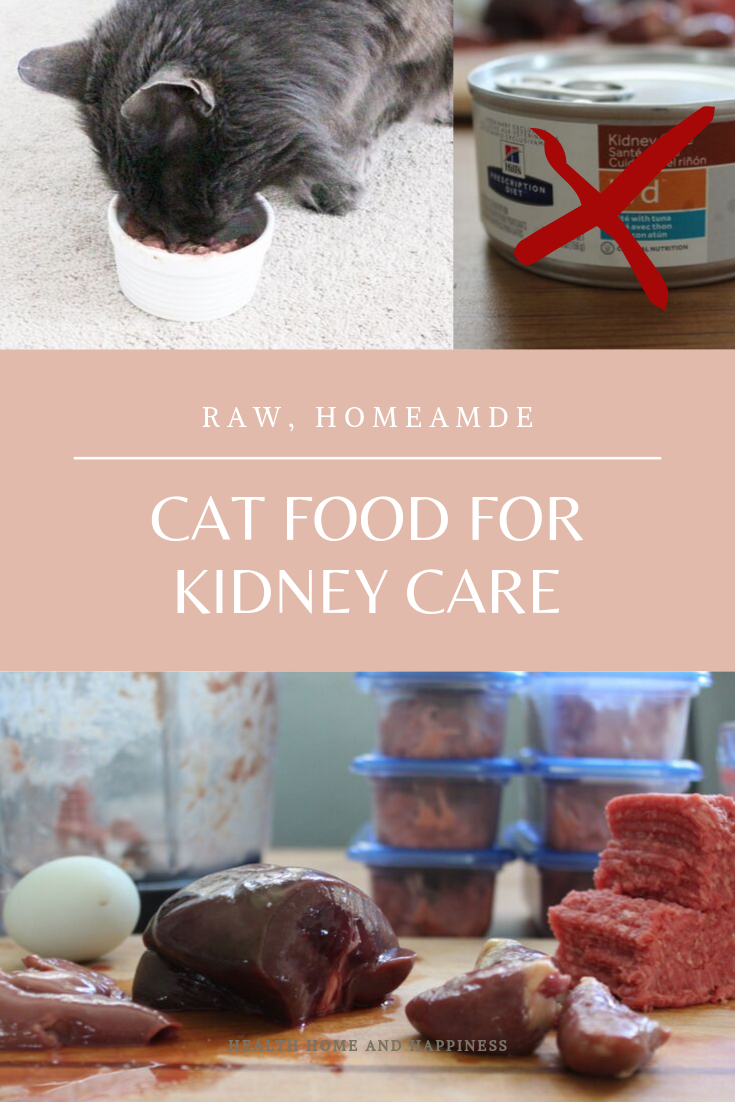
Learn how to heal leaky gut

60-page ebook of all my best GAPS Diet (Gut and Psychology Syndrome) articles all in one place.


Thanks, Cara. I love the idea of feeding my cats a more natural diet. How much of this recipe do you feed per day? My cats are each about 15 pounds (not Maine Coons, just large “boned”).
Bob is supposed to be gaining weight, so he can have as much of this as he will eat. He usually eats 100 calories a day, but I used this calculator to calculate what he needed and the chart I included in the post to calculate how much that was :) https://www.petnutritionalliance.org/cat.php
How many days approximately will this feed Bob? Would love just a ball park figure. Thank you.
Hi Starlene! This feeds bob for about a month.
I think 16 days, 8 containers with 160 grams, Bob eats 80 grams a day so 2x 8 = 16 and not a month. Correct me if I am wrong!
I think that’s right! I don’t remember, he’s fed as much as he wants since he needs to gain.
Hi Cara,
Have you switched up the diet to use other proteins? My guy can’t do chicken, beef or salmon as determined by Nutriscan testing. I’m currently using turkey but am having a difficult time finding a low phosphorus, balanced recipe.
Hello. I do not live in the usa… i will make the recipe. What isxmeant by sardines? The kind that come in a can? Aren’t they salty? Thank you!! Ilana
Hi Cara!
Thank you for this recipe! My 15 year old cat was recently diagnosed with kidney disease and does not like the commercial food–for which I do not blame him.
I tried to approximate a small batch of this recipe (without the beef–and without a proper scale) last night and he loved it! I am hopeful…
a couple of questions:
1. My grocery store only has chicken hearts in a package with chicken gizzards. Are they ok to use as well? (I cannot tell the bits apart)
2. The recipe says it yields 21 servings. Is that correct???? It seems to be a way smaller amount when I add the grams. And is the nutritional info and calorie content divided by the number of servings? (I may just be confused!)
3. Is there something I ought to worry about using raw food–which I had not done before??
4. To get my non-kidney cats involved with raw as well, is it simply a matter of adding bone meal?
Thank you!!!
For the heart- you want to be sure they are hearts; gizzards won’t give the same amount of nutrients. For the serving size, I suppose it depends on how much your cat needs. For your non kidney cats, I’d use bone-in chicken in place of the beef.
Hi Cara
I live in the UK and have two 11 yr old cats (not related, just the same age). I had recently started buying more expensive, natural types of catfood for them, as they both seemed to be getting fed up with their regular ‘senior’ wet food, even the greedier cat. Both were Ok with their dry biscuits. However, the greedier cat was diagnosed last summer with kidney disease and she is now on just a veterinarian diet. Wet and dry food. I have done a bit of my own chicken with broth and carrots (found online and meant to be OK as a change, for cats with kidney disease). I stumbled across your recipe and video. Your finished food looks just like one of the renal tins she is on. It all seems to make sense and I have got all the ingredients now to make it. She had gone off of beef in her regular catfood a while back and so hoping she is ok with the fresh ground mince and beef kidney taste etc. My main question, is whether your cat’s blood tests have shown any improvement at all and definitely not gone backwards, medically?
Many thanks.
I was wondering if you can use elk, deer or rabbit for any parts of this recipe. I am just starting a rescued kitty with kidney failure on it and am hopeful this will turn her around.
Hello! I wanted to try this diet for my cat and was wondering if there is a major difference in using beef kidney as compared to pork kidney?
Wish this was converted from metric measurements. How much ch oil do you add and where do you get it? Thanks!
Seems easy enough to do yourself since she has been so generous enough to provide is this great recipe at no cost. A little work on our end to convert the measurements seems reasonable. For her to customize for someone else doesn’t seem reasonable. Everyone wants something for free nowadays though. SMH.
Hi cara thank you soo much for helping us to save our lovers pets I want to ask you if I can change the beef with another protein source like chicken or duck ?
Thank you, Cara.
My cat was just diagnosed for kidney disease and hyperthyroidism. She really likes Hill’s KD . The dry food feels greasy, so I think they must coat it with fish oil to make it more attractive to cats. Mitzi already seems to be improving, after less than a week, with the diet and the pill for the hyperthyroidism.
She’s happy, but I am not. Well, I am happy she is getting better, of course. What I am not happy about is the cheap ingredients they use, for which they up the price just because it is a prescription diet. Brown rice as the first ingredient. Really? For a carnivore?
Which is why I found your website. Thank you for doing the hard work for us and sharing your recipe. We are leaving on vacation in a few days, but I plan to make it and wean her onto it after we get back at the end of the month.
I noticed a couple of people asked about substituting chicken thigh for beef, so I hope you don’t mind my posting a link. This site shows the phosphorous levels for different types of meat. Turns out chicken thighs are the lowest, although hamburger is not much higher. This article might be helpful for those who need to adjust your wonderful recipe to suit their kitty’s palate, or other health needs.
https://www.davita.com/diet-nutrition/articles/advice/top-low-phosphorus-foods-for-a-healthy-kidney-diet
Hi Cara, I have a kitty with Kidney failure and would love to start feeding him this raw food diet. The meat source you provided is sold out of most of what’s needed. Do you know of another source? Also are there any suppliers you know of where I can get the food already made?
100 grams raw salmon bones the link didn’t work, but honestly I am looking for a recipe for my CKD (early stage 3) diagnosed cat where the ingredients can all come from the WalMart grocery store.
Thank you for this! Did you use 100 grams of chicken heart? In the video it sounded like you used about 50. Also, how has Bob’s weight gain been?
The link to the Facebook group is broken. Would you be able to give me the name of the group so I can find it?
Also would love an update on Bob. Is your blog searchable?
How’s your kitty doing? Mine’s not into beef, can I sub with the same amount of chicken thighs?
I’m a long-time feeder of raw homemade for cats, but was interested in how it differs for a cat with chronic kidney disease. So, thank you! :)
I have a question – what about iodine? The recipes I found all include some kind of low/light iodized salt. If we’re not including the thymus gland of the animal, isn’t adding iodized salt important?
7/8/2021
I have two elderly cats with advanced kidney disease, and hate the k/d can and dry kidney food. I have been giving my cats raw range free chicken livers, chicken hearts, and gizzards. But, I am worried about. the vitamin A. I have been adding the about 1/2 teaspoon to organic turkey meat, with some vegetables, and fruits, that are also processed in a processor. I have been using Dr. Martys dehydrated raw food , as a supplement. I know it has too much protein, so, I am cutting down on the protein, by using the k/d diet, which I hate.
I saw your diet, and it has hamburger in it. My cats throw up, on beef. They do better on turkey and chicken, with organ meats. But I need to make sure I give them a balanced amount, so I asked the butcher at our Co-op store, if he would grind the organ meats together. So, I have been using a baby teaspoon, every other day.
I feel that I need a better balanced solution. I don’t want to make my cats sick, by not balancing their nutrition needs properly. A nutritionist will no doubt want to add grains to the food which add starch, which can cause hyperthyroidism, which one of my cats, already has.
But the meat should be limited, along with the phosphorus , shouldn’t it ? Can you give me a reci[pe, that will address kidney disease, and hyperthyroidism for one of my cats ? and one that only addresses kidney disease, by iself. I wonder if I shouldn’t lightly cook the outside of the meat, since they two elderly cats are 19 years old ?
Hi Cara,
How is Bob?
Lots of conflicting information on the internet on this topic.
I would appreciate hearing how Bob did overtime. Thank you.
Jess
Hi Cara.
I just found out that my 17 yr old kitty has kidney failure. I am very interested in doing the whole raw diet for her.
I did notice that the recipe you have listed asks for 70/30 ground beef, but the numbers with calories/protein amounts has ground beef at 85/15%…. also the video says 800 grams of ground beef and the recipe shows 700 gr…. can you please let me know what should be the actual recipe please? Anything you can provide will be helpful.
Thank you so much.
Hi Kay, I use some salmon in addition to the ground beef now, and reduce the beef. For 85/15 or 70/30, it depends on what you can find. The phosphorous level is still low enough with either one.
Hi Cara,
I just finished making my first batch of Bob’s favorite. Wow! That was a big chore but I know it will be easier next time. Thank you for all the information on site
I did find Salmon oil on Amazon.com very reasonably priced. Is there some way I could speak with you as I have many questions and am a senior citizen with difficulty on media correspondence?
Hi Cara,
When you say you use salmon in addition to the ground beef, what do you mean? ~ how much raw salmon and how much ground beef ~ my cat doesn’t like beef as much as chicken, so I would prefer to use chicken, someone above made a comment that their cat also does not like beef but chicken ~ what do you think? you use ground beef due to its phosphorus content ~ is that why? ~ maybe chicken doesn’t have that phosphorous content? ~ my cat does not show signs of kidney disease only that I noticed he was thirsty a lot, but the vet said to definitely introduce more wet food! I have and noticed he is not as thirsty.
I am unable to find raw chicken heart. What can I substitute for it, please?
You can omit it and add taurine. You’d have to look up how much taurine to give your cat per day based on weight.
My 17 year old cat, Aloha, was losing weight and in general, not doing well and not eating the kidney diet from the vet. I started making your recipe about 3 weeks ago and it’s like I have a new cat! She loves it and is putting weight back on, I don’t think I’ve ever seen her eat so much. She was also vomiting every night so I also add 1/16 tsp of slippery elm powder to each 4 oz of food and it’s really helped that. Mahalo from Maui!
How many egg shella for 6 gram powder?
I would buy a postal scale that weighs grams. I bought one under $10 on Amazon.
Hi Cara,
My 17 year old Manx cat just recently got diagnosed with kidney disease. My husband found your recipe and we made it for our cat. He loved it and ate it all up…but to our dismay a little while after he ate he threw it all up. I’m wondering if we gave him too much all at once…should we mix a little at a time with his current food?
Thank you so much for this video, and article. My cat has just been diagnosed with kidney disease. The cat food is quite expensive as you mentioned. He and his mother will both have to eat the same food since they eat in the same location in the house and it would be very difficult to have them on separate diet. The cost of 120 cans a month of prescription diet is insane. And I will definitely be giving this a try. Again I appreciate so much that you shared this
The vet recommended 2 cans of the 5.5 oz cat food (1.5 cans of the 3 oz ones). The 5.5 oz can is 156 grams(96 cal/100grams) so approx 300 cal/day.
Is the above recipe 100 cal per 100 grams? Approximately?
Thanks
My cat just got diagnosed with stage 3 CKD. I asked my vet about using homemade recipes. She said to avoid raw food as it carries increased risk of infection for salmonella, E. Coli and other bacteria. Cats with renal disease are more at risk for developing urinary tract infections and even kidney infections.
What have you found?
Thank you!
I’ve got five cats but only one with renal diet needs. Can I feed them all the renal diet?
I’d add in bone for phosphorous for your other cats.
This is an interesting story to follow. We’ve been through prescription diets for a few of ours over the last few years and I also am not a fan of the ingredients. I’ve begun to add home made and to supplement to canned and kibble. We have one who just got radioactive iodine treatment for hyperthyroid and may have some early kidney issues so I would prefer to do a home made kidney safe diet. His creatinine was normal but urine a bit dilute so we have to recheck his levels once the thyroid settled down and see what he needs. So far I just started with a nutrient mix called alnutrin you add one packet to 1lb of raw meat grind and freeze. I do lightly cook the meat starting out but am cooking less each time. They have an eggshells calcium one as well as one without calcium if you get your meat with bones. Id love to hear how Bob is doing with the diet. Thank you.
Cara,
I just want to confirm, I will be making this recipe for the first time this weekend. Your recipe calls for 100 grams of chicken hearts, but when you were making the video you used a smaller portion of chicken hearts, I think it was 50 grams.
Which amount is the correct amount for the recipe? I don’t want to use to much or too little of chicken hearts.
I’m excited to try this recipe. Thank you for the research.
Thank you for the helpful information. So does your cat also have to have lactated ringer solution and also this raw diet?
How do you adjust cats to eat this diet?
Where do you find taurine?
Only one of 5 have a kidney issue. Are bones good for cats who do not have teeth without kidney issues?
I’ve found that when adding chicken, I only grind the rib bones because they are smaller. After a good grind they can easily be pulsed in the food processor to ensure the texture is most palatable. Per my vet, cats should only be given bones that you can easily break with your bare hands and raw. I think its a great rule of thumb!
Hi, Cara.
Thanks for the detail and well-thought recipe. I will try to make the food for my 15-year-old girl who was just diagnosed with overactive thyroidism with early kidney failure. However I cannot find beef kidney or any kind of raw kidney as I am not in the States. The only kidney available is pig kidney which I will not use due to safety concern.
Can I just skip the kidney? Or should I add more chicken heart or other ingredients to compensate it?
Looking forward to making this for our 15 yr old Siberian. We’ll let you know how it goes
Hi Cara!
When I was doing TNR work with feral cats I had 14 at one time on my rural property. After losing 3 cats to hyperthyroid issues I got serious about researching raw. I started with a local raw food maker who delivered but the cats never transitioned well to the food so I started making my own. Cats are carnivores so cannot survive on a veg diet. Using vegetables was my first mistake. It took a few years of trial and error and research to come up with a raw meat diet that my current two cats have been thriving on for several years. I’ve been making raw cat food for 15+ years. I use ground turkey thigh meat, chicken livers, egg yokes, pumpkin, taurine, supplement, bone meal, water. My food is far more expensive, about $75/month for two cats. I use 1 can of raw pumpkin with the 10 lbs of ground turkey for fiber. I use 4 cups of water. One of my cats was feral, the other was an abandoned cat and lived on the streets for a year. Both have been with us for about 8 years now. They are both in peak health which I attribute to their raw diet. In my research I found that cats cannot digest raw egg white-did you find different? So good to see you and the kids doing well and the business thriving! Love to you all …
Hi Darris, that sounds interesting! Can you, please, write the full recipe?
Hi. Thank you for the information. I read cats with ckd should not eat fish but you are. Why so? I’m so confused what to do for my baby boy.
Hello Cara,
I just found out that my only 6 month old kitten has kidney failure :(
I want to try this out for her but I don’t know if the proportions would be different for a young kitten. Can you please help me out with the calculations? I am very desperate. My vet recommended Hill’s kidney care but again the cost adds up.
Hello Cara,
I live in Australia & I was shocked by the cost of the Hills Kidney food. Here it is $3.55/can & $2.55/satchel. I bought a couple of cans to keep my rag-doll cat going over the weekend until I went to the butcher. Long story short, the cat loves it. I also put a bit of salmon into it because, like Bob, my cat likes fish.
Thank you for making this video. It as been a godsend.
Hi there! I’m in New Zealand, and just made this for my senior cat who’s got renal/kidney issues – it was a challenge to source all of the ingredients, but I got there, and my cat LOVED it – hopefully she hasn’t guts herself too much on it and made herself sick… but I’m really hopeful to see her start to gain weight and increase her qualify of life again. Thank for your research and sharing :-)
I live in NZ too, I get all the meat bits at Pak’n save.
Hi Cara, I was wondering how long after you started feeding it that it took you to notice a weight gain? I’ve been feeding my cat this for a couple weeks he seems to love it but his appetite hasn’t improved a whole lot.
My Boy was diagnised with CKD in December 2020 at the age of 17. He is on Phenobarbital, twice daily in order to control seizures, I will be making this recipe for him. Shoppng for the ingrdients tomorrow. Thank you and looking forward for more recipes to try.
So in doing some research I found this https://www.veterinarynutritiongroup.com/post/should-i-feed-my-cat-with-chronic-kidney-disease-a-raw-diet. Was wondering if what you put above covered all the vitamins and nutrients? I do not want to start giving my furbaby the stuff from the vet or any more of the dry stuff. I am wondering if I give her your recipe for a week then do the other one for a week or do you think that would be too much. I wish someone would make book for cats with CKD with different recipes so there is a variety to choose from.
100 grams raw salmon bones the link didn’t work, but honestly I am looking for a recipe for my CKD (early stage 3) diagnosed cat where the ingredients can all come from the WalMart grocery store.
I am so scared of raw poultry, or even beef in 2022, with the diseases they have been found to have. Could be from the source, the processing plant, or the worst how it was handled from there on down to the moment you purchase it.
Hi what was the name of the Facebook group. The link is not working for me
Can anyone please help. I need to use this recipe to feed 5 cats for 30 days at a time. Can anyone help with the quantities.